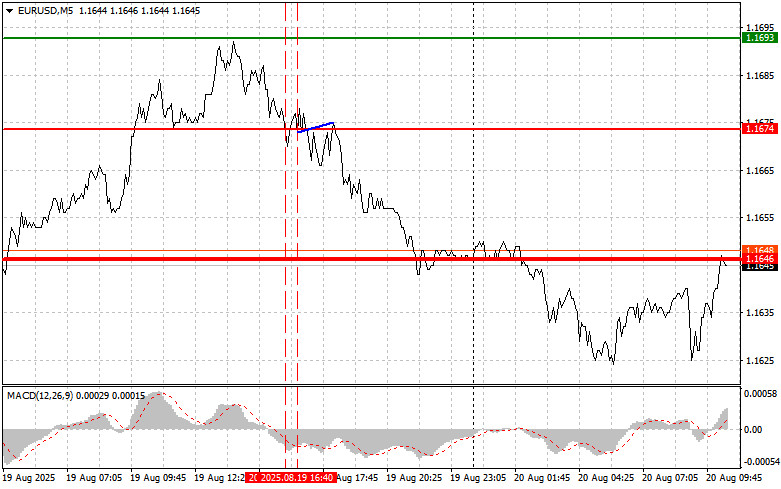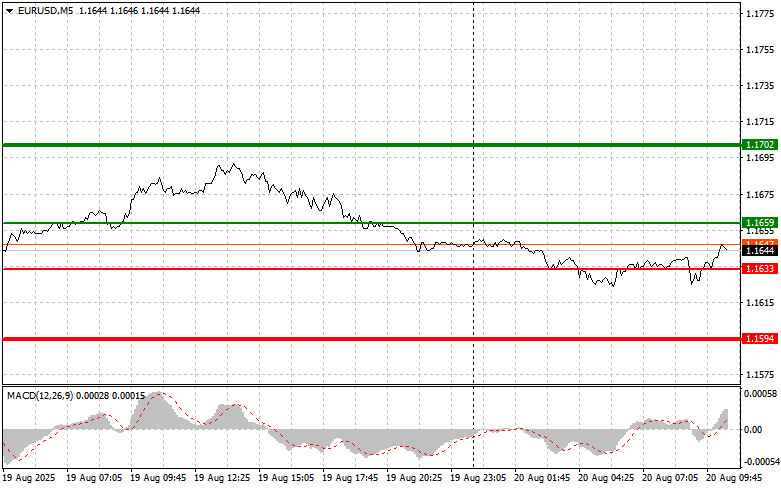Analysis of Trades and Trading Tips for the Euro
The first test of the 1.1674 price level occurred when the MACD indicator had already moved well below the zero mark, which limited the pair's downside potential. For this reason, I did not sell. The second test of 1.1674 came at a time when the MACD was in the oversold area, which allowed scenario #2 for buying the euro to materialize. However, the pair did not manage to show significant growth.
Despite unfavorable U.S. housing sector data, the American currency strengthened against the euro. Geopolitical instability in Europe is weighing negatively on the euro, while uncertainty over the Federal Reserve's stance on interest rates still plays in favor of the U.S. dollar.
Today, market attention will be focused on the release of the eurozone Consumer Price Index, Germany's Producer Price Index, and the speech by European Central Bank President Christine Lagarde. These events are expected to significantly impact currency fluctuations, especially the euro—the eurozone CPI will serve as the key inflation indicator for the region. If the figures confirm inflation holding near the European Central Bank's target level, it may encourage further interest rate cuts, which would put pressure on the euro. Germany's Producer Price Index will reflect the dynamics of industrial goods and raw material prices. An increase in this index may signal potential strengthening of inflationary pressures in the future.
However, most likely, all attention will be on Christine Lagarde's speech. Investors will closely analyze her statements about the current state of the economy, inflation forecasts, and the ECB's future policy. Any hints at a more hawkish stance could strengthen the euro, while signals of readiness for a more dovish approach may weaken it.
For intraday strategy, I will focus primarily on Scenarios #1 and #2.
Buy Scenario
Scenario #1: Today, the euro can be bought at around 1.1659 (green line on the chart) with a target at 1.1702. At 1.1702, I plan to exit the market and sell the euro in the opposite direction, expecting a 30–35-point move from the entry level. Counting on euro growth is possible only after very strong data. Important! Before buying, ensure the MACD indicator is above zero and is only just starting to rise from it.
Scenario #2: I also plan to buy the euro today if there are two consecutive tests of the 1.1633 price level at a time when the MACD is in the oversold area. This will limit the pair's downside potential and lead to an upward market reversal. Growth toward the opposite levels of 1.1659 and 1.1702 can be expected.
Sell Scenario
Scenario #1: I plan to sell the euro after it reaches the 1.1633 level (red line on the chart). The target will be 1.1594, where I intend to exit the market and immediately buy in the opposite direction, counting on a 20–25-point rebound from that level. Pressure on the pair may persist today. Important! Before selling, ensure the MACD indicator is below zero and is only just starting to decline from it.
Scenario #2: I also plan to sell the euro today if there are two consecutive tests of the 1.1659 price level at a time when the MACD is in the overbought area. This will limit the pair's upside potential and lead to a downward reversal of the market. A decline toward the opposite levels of 1.1633 and 1.1594 can be expected.
What's on the Chart:
- The thin green line represents the entry price where the trading instrument can be bought.
- The thick green line indicates the expected price level where a Take Profit order can be placed, or profits can be manually secured, as further price growth above this level is unlikely.
- The thin red line represents the entry price where the trading instrument can be sold.
- The thick red line indicates the expected price level where a Take Profit order can be placed, or profits can be manually secured, as further price decline below this level is unlikely.
- The MACD indicator should be used to assess overbought and oversold zones when entering the market.
Important Notes:
- Beginner Forex traders should exercise extreme caution when making market entry decisions. It is advisable to stay out of the market before the release of important fundamental reports to avoid exposure to sharp price fluctuations. If you choose to trade during news releases, always use stop-loss orders to minimize potential losses. Trading without stop-loss orders can quickly wipe out your entire deposit, especially if you neglect money management principles and trade with high volumes.
- Remember, successful trading requires a well-defined trading plan, similar to the one outlined above. Making impulsive trading decisions based on the current market situation is a losing strategy for intraday traders.













